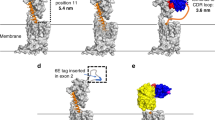Abstract
Heteromultivalency provides a route to increase binding avidity and to high specificity when compared to monovalent ligands. The enhanced specificity can potentially serve as a unique platform to develop diagnostics and therapeutics. To develop new imaging agents based upon multivalency, we employed heterobivalent constructs of optimized ligands. In this report, we describe synthetic methods we have developed for the preparation of heterobivalent constructs consisting of ligands targeted simultaneously to the melanocortin receptor, hMC4R, and the cholecystokinin receptors, CCK-2R. Modeling data suggest that a linker distance span of 20–50 Å is needed to crosslink these two G-protein coupled receptors (GPCRs). The two ligands were tethered with linkers of varying rigidity and length, and flexible polyethylene glycol based PEGO chain or semi-rigid [poly(Pro-Gly)] linkers were employed for this purpose. The described synthetic strategy provides a modular way to assemble ligands and linkers on solid-phase supports. Examples of heterobivalent ligands are provided to illustrate the increased binding avidity to cells that express the complementary receptors.




Similar content being viewed by others
Abbreviations
- GPCR:
-
G-protein coupled receptor
- hMC4R:
-
Human melanocortin-4 receptor
- CCK-2R:
-
Cholecystokinin-2 receptor
- α-MSH:
-
α-Melanocortin stimulating hormone
- MSH-7:
-
Ac-Ser-Nle-Glu-His-DPhe-Arg-Trp-
- CCK-6:
-
-Nle-Gly-Trp-Nle-Asp-Phe-NH2
- PEGO:
-
19-Amino-5-oxo-3,10,13,16-tetraoxa-6-azanonadecan-1-oic acid
- Fmoc:
-
9-Fluorenylmethyloxycarbonyl
- Boc:
-
Tert-butyloxycarbonyl
- HOBt:
-
1-Hydroxybenzotriazole
- HOCt:
-
6-Chloro-1-hydroxybenzotriazole
- HBTU:
-
o-[1H-Benzotriazol-1-yl)(dimethylamino)methylene]uranium hexafluorophosphate N-oxide
- DIC:
-
Diisopropylcarbodiimide
- DIEA:
-
Diisopropylethylamine
- Pbf:
-
2,2,4,6,7-Pentamethyldihydrobenzofuran-5-yl sulfonyl
- Trt:
-
Triphenylmethyl (trityl)
- TFA:
-
Trifluoroacetic acid
- MALDI-TOF:
-
Matrix assisted laser desorption ionization-time of flight
- ESI-MS:
-
Electrospray ionization-mass spectrometry
- FT-ICR:
-
Fourier transform-ion cyclotron resonance
- Hek-293 cells:
-
Human embryonic kidney cells
- TRF:
-
Time-resolved fluorescence
References
Caplan MR, Rosca EV (2005) Targeting drugs to combinations of receptors: a modeling analysis of potential specificity. Ann Biomed Eng 33:1113–1124
Fourmy D, Escrieut C, Archer E et al (2002) Structure of cholecystokinin receptor binding sites and mechanism of activation/inactivation by agonists/antagonists. Pharmacol Toxicol 91:313–320
Gillies RJ, Hruby VJ (2003) Expression-driven reverse engineering of targeted imaging and therapeutic agents. Expert Opin Ther Targets 7:137–139
Handl H, Gillies RJ (2005) Lanthanide-based luminescent assays for ligand-receptor interactions. Life Sci 77:361–371
Handl HL, Vagner J, Han HY, Mash E, Hruby VJ, Gillies RJ (2004a) Hitting multiple targets with multimeric ligands. Expert Opin Ther Targets 8:565–586
Handl HL, Vagner J, Yamamura HI, Hruby VJ, Gillies RJ (2004b) Lanthanide-based time-resolved fluorescence of in cyto ligand-receptor interactions. Anal Biochem 330:242–250
Handl HL, Vagner J, Yamamura HI, Hruby VJ, Gillies RJ (2005) Development of a lanthanide-based assay for detection of receptor-ligand interactions at the δ-opioid receptor. Anal Biochem 343:299–307
Handl HL, Sankaranarayanan R, Josan JS et al (2007) Synthesis and evaluation of bivalent NDP-α-MSH(7) peptide ligands for binding to the human melanocortin receptor 4 (hMC4R). Bioconjug Chem 18:1101–1109
Hornick CL, Karush F (1972) Antibody affinity-III. The role of multivalence. Immunochemistry 9:325–340
Krchnak V, Vagner J, Lebl M (1988) Noninvasive continuous monitoring of solid-phase peptide synthesis by acid-base indicator. Int J Pept Protein Res 32:415–416
Mammen M, Choi S-K, Whitesides GM (1998) Polyvalent interactions in biological systems: implications for design and use of multivalent ligands and inhibitors. Angew Chem Int Ed 37:2754–2794
Monguchi Y, Vagner J, Handl HL et al (2005) Design, synthesis, and validation of rigid linkers for bioactive peptides. Tet Lett 46:7589–7592
Sharma SD, Granberry ME, Jiang J, Leong SDL, Hadley ME, Hruby VJ (1994) Multivalent melanotropic peptide and fluorescent macromolecular conjugates: new reagents for characterization of melanotropin receptors. Bioconjug Chem 5:591–601
Sharma SD, Jiang J, Hadley ME, Bentley DL, Hruby VJ (1996) Melanotropic peptide-conjugated beads for microscopic visualization and characterization of melanoma melanotropin receptors. Proc Nat Acad Sci USA 93:13715–13720
Vagner J, Handl HL, Gillies RJ, Hruby VJ (2004) Novel targeting strategy based on multimeric ligands for drug delivery and molecular imaging: homooligomers of α-MSH. Bioorg Med Chem Lett 2004:211–215
Vagner J, Handl HL, Monguchi Y et al (2006) Rigid linkers for bioactive peptides. Bioconjug Chem 17:1545–1550
Vagner J, Xu L, Handl HL et al (2008) Heterobivalent ligands crosslink multiple cell-surface receptors-the human melanocortin-4 and δ-opiod receptors. Angew Chem Int Ed 47:1685–1688
Acknowledgements
We thank Ms. Lucinda Begay and Mrs. Renata Patek for HPLC and technical assistance. This work was supported by grants R01 CA 123547 and RO1 CA097360 from the National Cancer Institute and Grant ABRC06-006 from the Arizona Biomedical Research Commission.
Author information
Authors and Affiliations
Corresponding author
Rights and permissions
About this article
Cite this article
Josan, J.S., Vagner, J., Handl, H.L. et al. Solid-Phase Synthesis of Heterobivalent Ligands Targeted to Melanocortin and Cholecystokinin Receptors. Int J Pept Res Ther 14, 293–300 (2008). https://doi.org/10.1007/s10989-008-9150-3
Received:
Accepted:
Published:
Issue Date:
DOI: https://doi.org/10.1007/s10989-008-9150-3




